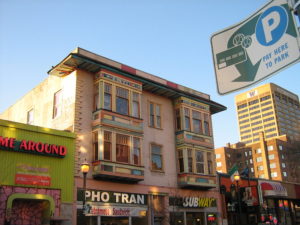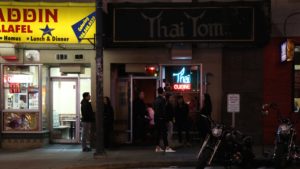We asked folks who filled out our survey about the U District to respond with their own questions about the neighborhood. We sifted through your responses and picked a few intriguing lines of inquiry to answer. And don’t forget to check out our complete guide to the neighborhood.

📜 I heard there’s some rich history with Shiga’s Imports and its connection to the Ave — would be interested in hearing more.
There is indeed some rich history! The store’s original owner, Andy Shiga, was a notable figure in the neighborhood’s past and was a driving force in creating the U District Street Fair. As one might expect for a store that’s been around for some time, Shiga’s Imports recently underwent some renovations.
If you’re interested in learning more about the store, check out this Seattle Globalist article from a few years ago: Shiga’s Imports weathers a half century of changes on the Ave
🏡 What is the percentage of non-students who live in the neighborhood?
That particular number is hard to find but the Department of Neighborhoods did release a report on the U District in 2018 that helps give an idea. Compared to the whole city, 95.7% of households are renters. A report from the U District Partnership reinforces the prevalence of students in the neighborhood, finding that the median age is 22 and that the total population is about 31,000. The UW’s enrollment is over 40,000.
🚝 Will the new light rail station have any open public space?
The U District Partnership recently opened a new outdoor dining plaza at NE 43rd Street! It’s right in front of businesses like Flowers, Cedar’s of Lebanon, and Sweet Alchemy. The street now features a number of benches with umbrellas and is closed off to any traffic. Head over there, say hi to Samir, and go support these local businesses.
➡️ What businesses have we lost here in the pandemic?
Here’s an incomplete list sourced from various articles:
College Inn Pub (Was purchased by new owners but has yet to reopen)
Jet City Improv (Building demolished but will continue temporarily out of University Heights)
Cafe Racer (Plan to reopen eventually in a new location)
University Temple United Methodist Church (Building to be demoed, moved offices to U Bookstore basement and will resume services at the Masonic Lodge)
Seven Gables Theatre (Burned down)

🤝 What are some community-based organizations or nonprofits to volunteer at?
There are a ton of different organizations and nonprofits based in the neighborhood worth supporting. Here are a few:
University District Food Bank — You can watch our “Have a drink with” the org here. The group is always looking for monetary donations, pantry items, and volunteers to help with distributing food.
University Heights Center — As its website says, “UHeights Center promotes lifelong learning, creativity, culture, community activism, and the preservation of our historic building.” Among other things, the center has created a Safe Lot for those living in their cars, installed a Seattle Street Sink, and hosts a free vegetarian food truck four days a week during the pandemic. In addition to volunteer opportunities, UHeights Center is currently hiring an Outreach and Events Coordinator.
ROOTS Young Adult Shelter — With a focus on serving those between the ages of 18-25, ROOTS offers its guests shelter, access to a health clinic, and meals on Friday that are open to everyone. Find out how you can support the shelter’s essential mission on its website.
Teen Feed — This organization consists of three programs, one of which offers meals to folks in the U District at various locations seven days a week. Teen Feed also runs the Street Talk Outreach Program (STOP) which aims to assist high-risk youth who might avoid traditional social service agencies. Lastly, the group has a case management program called Service Links for Youth. More details on how to volunteer, donate, and support them can be found here.
Elizabeth Gregory Home — Located in the basement of University Lutheran Church, this nonprofit, non-faith-based organization works to support women experiencing houselessness. The org provides transitional housing, a day center, and case management services. Want to know how to support them? Check out the official website for opportunities and information on how to donate.
🍚 Is the U District Seattle’s capital of boba tea or teriyaki?
Speaking from a non-authoritative position, I can neither confirm nor deny this. But if you’re interested in the history of teriyaki in Seattle, I recommend reading this Seattle Weekly piece from 2007. You may not have realized it, but teriyaki is a very Seattle thing and not so much a Japanese one. For fans of Bon Appetit and Melissa Miranda, you can watch a recent video where she attempts to cook a classic Seattle-style teriyaki meal faster than the time it takes for it to be delivered to the studio.
As for boba — a cursory search on Google Maps makes it appear as though it’s safe to say the U District is indeed Seattle’s capital of bubble tea.
🏍 What’s the story behind the Wall of Death along the Burke Gilman?
There’s a great article from Atlas Obscura that dives into the notorious art installation’s backstory. It was created by father-son duo Mowry and Colin Baden, and is supposed to resemble the cages used by performers to zoom around a cylindrical track fast enough to defy gravity.
🏢 Why do some many storefronts sit vacant for so long?
This is a really common question — and we couldn’t find any one article that definitively answers it — but we will try our best to provide some insight.
- There’s the simple problem of money. A study done in 2019 for the U District Partnership found that retail rents have increased by 50% over the past couple of decades due to a simultaneous rise in demand and decrease in retail space. Additionally, there’s an ongoing conversation concerning upzoning in the neighborhood.
- Reliance on the UW community. The U District isn’t solely inhabited by university-affiliated people, but they drive a large share of business for the neighborhood’s stores. The neighborhood isn’t nearly as bustling come summer when the school year is over, and thus, there’s less spending money circulating around.